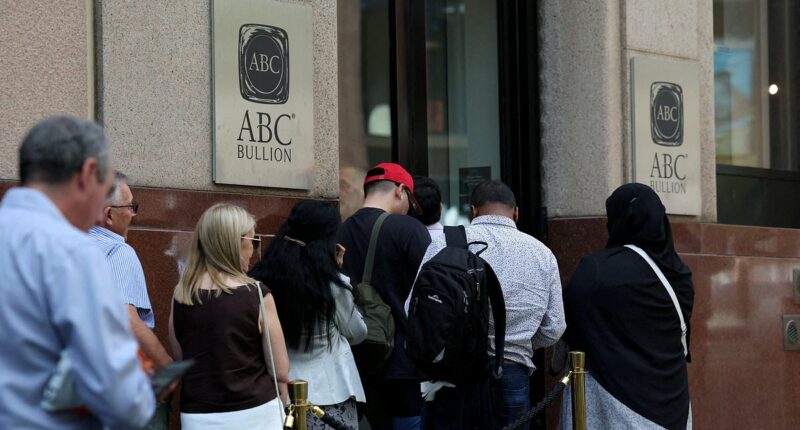Share this @internewscast.com
Gold has taken a dramatic nosedive, marking its steepest decline in 12 years, with prices plunging over six percent overnight. This unfortunate turn of events has hit Australians hard, especially those who had patiently lined up for hours to invest in the precious metal.
The value of gold fell by 6.8 percent, settling at USD$4,082.35 per ounce on Wednesday. This follows a remarkable surge earlier this year, where prices had climbed over 50 percent, reaching a high of USD$4,396.60.
Financial experts attribute the fluctuating prices to investors’ unease with the unstable US dollar and the banking sector’s volatility. These concerns have been exacerbated by unpredictable tariff policies from Donald Trump and renewed inflation fears sparked by the Federal Reserve’s hints at potential rate cuts.
The soaring prices fueled a buying frenzy, with Australians flocking to ABC Bullion in Sydney’s Martin Place, prepared to wait in long lines for their chance to purchase gold.
A photo posted on Reddit last Friday captured the scene, showing a line stretching around the corner and another extending towards a nearby café, effectively blocking access to other businesses in the area.
In response to the overwhelming demand, ABC Bullion’s general manager, Jordan Eliseo, has been compelled to extend trading hours and recruit five additional staff members over the past two weeks to manage the surge in customers.
He said it wasn’t uncommon to see lengthy queues outside the door from time to time.
‘But for this sustained period of weeks on end where there are queues forming before the store even opens… that’s a new phenomenon,’ he told Yahoo.

The price of gold has soared to a record almost $A6,700 an ounce in recent weeks, sparking wild scenes outside ABC Bullion in Sydney
‘But it’s important to point out that that physical queue is, in many ways, the tip of the iceberg.’
He added that the wild scenes were nothing compared to the digital queue of Aussies opening online accounts.
‘The amount of client activity that we see on that front, in some ways, has dwarfed the uptick in people coming to our stores to buy,’ Mr Eliseo said.
The gold rush was particularly busy in Australia last week due to the Hindu festival Diwali.
Nepali Australian Prakas told the Guardian he bought gold every year at this time of year; however, he had never seen ‘anything like this’ before.
Several customers have admitted they’ve made multiple visits to the store within a week.
‘At any time of conflict or any time of threat, gold is a sure thing in a time of upheaval,’ one man told Daily Mail earlier this month.
‘The paper money, the fiat money, can go up and down and collapse.’

The photo outside ABC Bullion in Sydney’s Martin Place last week showed one queue stretching around the corner and a second snaking into the neighbouring building
His wife added: ‘We’re not big buyers We’re pensioners, but that’s the way we manage ourselves,’
Photos of the in-store scenes baffled Aussies online.
‘People queuing to buy gold during a “cost-of-living” crisis. OK,’ one commented.
Another added: ‘Why are people lining up for actual gold when you can buy gold ETFs?’
Other cynics believe that the bubble is about to burst.
‘They would probably be making a wise investment if they did this months ago but now they’ve jumped on too late,’ one wrote.
Another added: ‘Tell me the bubble is about to burst without telling me. All aboard the hype train!’
However, the gold rush is showing no signs of waning anytime soon.

ABC Bullion general manager Jordan Eliseo described the recent queues as a ‘new phenomenon’
‘As the third largest miner of gold and with one of the largest gold reserves in the world, the Australian economy stands to benefit from recent price gains,’ a Commonwealth Bank investor note read on Tuesday.
‘We expect higher gold prices will transmit through the Australian economy in two ways: higher national income and higher investment.’
AMP chief economist Shane Oliver has stood by his prediction that the market is becoming speculative and vulnerable to a correction.
‘The risk of a pullback is rising,’ he said.
Australia is one of the biggest producers of the yellow metal in the world, alongside China, the US, South Africa, Russia, Peru, and Indonesia.
Gold earnings are due to increase to $60billion this financial year, which could mean a $4billion rise in the forecast over three months.

















